The iPad 2,4 Review: 32nm Brings Better Battery Life
by Anand Lal Shimpi on May 4, 2012 12:50 AM ESTWhen Apple launched the 3rd generation iPad (as the new iPad), it also dropped the price of the entry-level 16GB WiFi iPad 2 to $399. Apple's products tend to hold their values exceptionally well, so this two-tablet strategy made sense. Apple also proved the success of discount-the-previous-gen strategy with its iPhone line, where you can now buy current, n-1 and n-2 generations of iPhones at prices separated by $100.
What's different with the $399 iPad 2 is that Apple used it as a vehicle to introduce a new hardware platform, or more specifically, a new SoC.
The 32nm HK+MG Apple A5 SoC
Prior to the new iPad announcement there were three versions of the iPad 2:
| Apple iPad 2 Lineup | |||||||
| iPad 2,1 | iPad 2,2 | iPad 2,3 | iPad 2,4 | ||||
| A5 SoC | 45nm LP | 45nm LP | 45nm LP | 32nm LP | |||
| Connectivity | WiFi | WiFi + GSM | WiFi + CDMA | WiFi | |||
The 2,1 was WiFi-only, the 2,2 was GSM and the 2,3 was CDMA. The new addition to the family is the iPad 2,4. The 2,4 replaces the original iPad 2,1. It's also only available in a single capacity.
There's no known way to tell whether you're getting an iPad 2,4 vs. the older iPad 2,1 without opening the box. The 2,4 unit I ended up with was made in China, ruling out manufacturing region as a way of telling. The external box looks identical, as does the device itself.
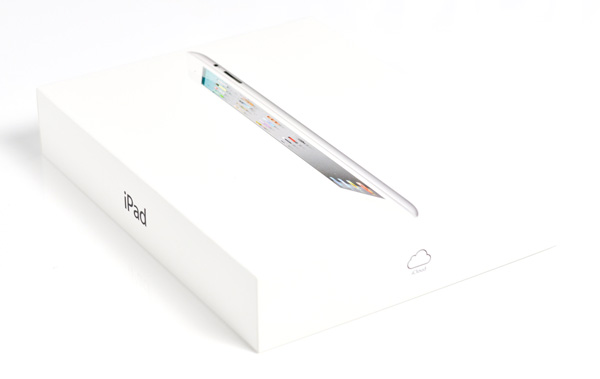
The newer iPad 2,4 units should come with iOS 5.1 preloaded, while any older iPad 2,1 stock may have 5.0.1 or older. But the most accurate way to tell is by looking at what a utility like Geekbench will tell you about the hardware (Update: there are other free utilities that can serve the same purpose, Linpack and Battery Life Pro are two examples):

This particular iPad 2,4 sample came from Best Buy, and several attempts to find one elsewhere came up short. All indications seem to point to the iPad 2,4 being relatively rare, which makes sense considering what's inside it.
Although the iPad 2,1 and its 3G brethren all used a 45nm Apple A5 SoC, the iPad 2,4 uses a die-shrunk 32nm version. The performance remains the same, but the die is much smaller. This isn't however just a normal die shrink, as Apple is using Samsung's 32nm high-k + metal gate LP transistors for this new A5 die. Intel was first to make the HK+MG transition back at 45nm in 2007 and correctly predicted that no one else would make the move until 32nm at the earliest.
Transistors are amazingly complex to fully understand, but at a high level they're quite simple. Imagine a transistor as a silicon based switch. When on, current flows, and when off, current stops flowing. The smaller you make a transistor, the more likely it is to misbehave. If current flows while the transistor is off, you waste power. This is known as leakage current and can come from a number of sources.
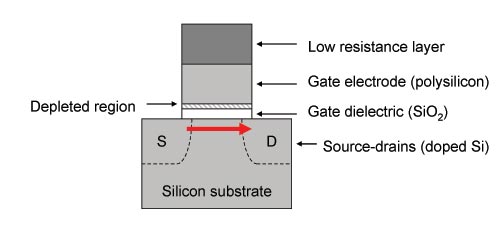
One such source is the gate oxide/gate dielectric, a particularly thin part of modern day transistors - on the order of a handful of atoms thick. Thinning the gate dielectric is desirable up to a certain point, after which the dielectric simply leaks too much power. Switching to a different material here, specifically one with a higher dielectric constant (a higher k-value), can significantly reduce leakage current and mitigate this issue. This is exactly what the first part of Samsung's 32nm high-k + metal gate process does.
The second half of the new process is the introduction of a metal gate electrode. Switching from a polysilicon to a metal gate electrode results in higher drive current by elimination of a region of depleted conducting carriers between the gate electrode and gate dielectric.
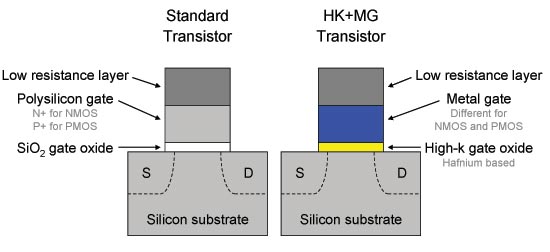
The combination of these two innovations results in less wasted current and more efficient current delivery, which in turn can give us a more power efficient chip. It's a net win. It makes manufacturing more complex, and there's definitely a learning curve to implementing it, but after you get over that hurdle it becomes just another part of the process.
The More Cost Effective Die
Traditionally the move to a smaller process node brings about an increase in transistor density. As transistors get smaller, you can fit more of them into the same space (or the same number into a smaller space). It's this basic principle that makes Moore's Law work. If you can keep shrinking transistor size by about 50% every two years, you'll theoretically be able to double transistor count at the same cost every two years (or cut cost in half every two years). In practice it doesn't work this well. Newer processes are always more expensive than their predecessors initially and logic scaling is never perfect.
It's rare these days that we actually see a pure die shrink anymore. With Intel's tick-tock model we almost always see increases in functionality to accompany each process node shift. In the case of Ivy Bridge, we actually saw a significant increase in transistor count thanks to an improved GPU. With Apple's 32nm A5 however, we truly end up with a die shrunk version of the 45nm A5 SoC. About the only part of the computing world where we see these pure shrinks is in the console space where performance doesn't have to go up within a generation, but cost must go down.
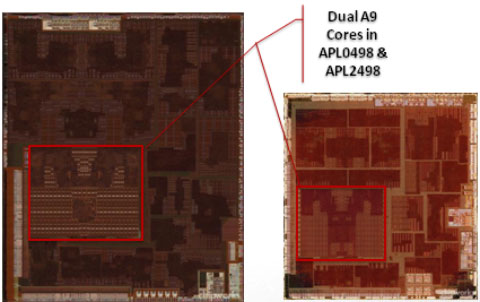
45nm A5 (left) vs. 32nm A5 (right) - Source: Chipworks
The original 45nm A5's die measured approximately 122mm^2. The new 32nm A5 has a surface area of only 69mm^2. That's actually amazingly good scaling at 57% of the old die size, as perfect scaling from 45nm to 32nm would be around 50.5%.
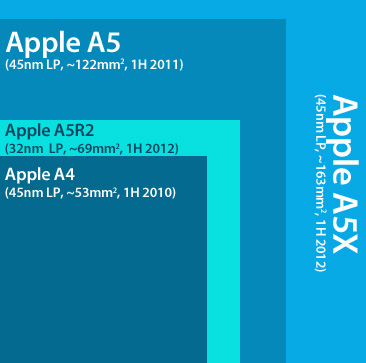
Assuming Apple could make full use of a 300mm wafer (which it can't, wafers are round, chips are rectangular at best so there are some unusable chips), Samsung could deliver 579 45nm A5 die to Apple. The move to 32nm would give Apple 75% more die per wafer at 1015 chips. Again both of these numbers are over estimates as they assume full usage of the surface area of a wafer as well as 100% yields, but you can see the benefit of a smaller die. As long as wafer costs increase by a factor less than the 75% increase in number of die per wafer, Apple can effectively reduce SoC cost by going this route.
These ARM based SoCs are already fairly cheap - all selling well below $30 (many around $15) - so there's not a whole lot of cost savings here. On a product like the $399 iPad 2, where Apple needs to do its best to maintain margins while holding onto (and growing) market share, every last dollar matters.

Gate density vs. process node at Samsung
There's another motivation for Apple however. Just as with any good microprocessor company, its best to introduce a new process technology on a known architecture. It's also a good idea to introduce a new process technology on lower volume products. The combination of both of these minimize risk. Should there be something wrong with the new process, introducing a new architecture on it just means you now have two very complex things to debug - the process technology and the chip's architecture. Should the new process not yield very well initially, you'd be similarly screwed if you were depending on it for your highest volume parts.
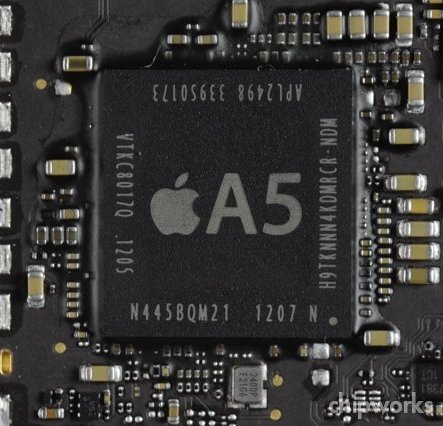
32nm A5 in iPad 2,4 (Source: Chipworks)
Apple decided to try out Samsung's 32nm HK+MG process on the A5 used in the 3rd generation Apple TV and some of the new iPad 2s. The former is a relatively low volume product for Apple, while the latter still moves in significant quantities. To deal with that fact, Apple is continuing to ship the original 45nm iPad 2,1 alongside the new 32nm iPad 2,4. Any hiccups in Samsung's production of the A5 and there are still more than enough iPad 2,1s to go around. The risk of moving to 32nm is effectively mitigated, while the learnings Apple gains from building the 32nm A5 will pay off later this year as Apple ramps up production of a 32nm SoC for use in the next iPhone. It's a very smart strategy, one you would expect from an experienced chip company - not a device vendor. When you consider that Apple employs chip architects who have worked on everything from the Athlon 64 to the Cortex A15, Apple's behavior is no longer that surprising.
Apple gets two benefits from the iPad 2,4: lower manufacturing costs, and experience with Samsung's 32nm HK+MG process which it will later use in much greater volumes. What about customers who end up with an iPad 2,4? Better battery life and cooler operation, of course.

Impact of HK+MG at Samsung
Remember the basics of Samsung's 32nm HK+MG process: a 40% performance improvement at the same leakage, or a 10x reduction in leakage at the same switching speed. As the iPad 2,4 retains the same clocks as the initial iPad 2, the benefit realized is a significant reduction in leakage current. This translates to tangibly better battery life.


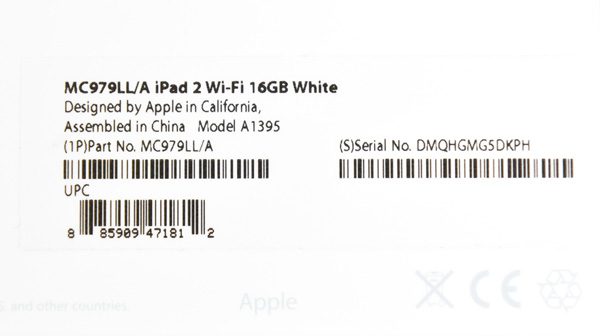








100 Comments
View All Comments
LittleMaNiaC - Monday, June 11, 2012 - link
HI guys! I would like to ask you all. Those who bought ipad 2,4 are from U.S right? I wonder did any of those ipad 2,4 went to Asia?machugger - Wednesday, June 27, 2012 - link
Why would an iPad 2 w/serial no. starting w/"DM" that was manufactured1) in the same factory as the 2,4
AND
2) AFTER April, when the 2,4 models were made
…why would it be a 2,1?!?!?!?!?
marketjock - Monday, July 30, 2012 - link
From Apple's website, when adding the iPad 2 16GB to your cart, the part number MC954LL/A is used. Is it safe to say when looking for a new one, to only look for MC954LL/A as that will have the 32nm chip?marketjock - Monday, July 30, 2012 - link
From what I have read, it does not matter the part number or the S/N. Any can have the 45nm or 32nm chip. It appears to be a matter of exhausting out the 45nm inventory.TechKnow12 - Wednesday, August 1, 2012 - link
Hi,If anyone is after the iPad 2,4 please read the following.
If you're in the US, look for:
MC769LL/A, 16gb, Black - Serial prefixes: DMQH, DMPH - both proven to be 2,4
MC979LL/A, 16gb, White - Serial prefixes: DMQH, DMPH
MC954LL/A, 16gb, Black - new model number, serial prefix not known - proven to be 2,4
MC989LL/A, 16gb, White - unproven but as it's the new model number it should be 2,4
If you're in Australia, look for:
MC769X/A, 16gb, Black, Serial prefixes: DMQJ, DMPJ - proven to be 2,4 by me.
MC979X/A, 16gb, White, Serial prefixes: DMQJ, DMPJ
The MC954 & MC989 appear to be US only models.
Please note that the Australian models may possibly have the prefix with H at the end instead of J and vice versa for US.
If you live in Australia I can confirm that the Apple Store in Perth has the DMQJ & DMPJ in stock. I purchased mine from Big W however I had to check with 4 stores before I found a DMPJ.
Battery Life
Okay so now you're wondering if the alleged extended battery life of 11.7 hours makes this worth buying or not.
Well, out of the box my iPad 2,4 had a charge of 76% and for the next 2 hours, from setting up, to installing my Apps, to surfing the net the charge only dropped to 66%. Wow! Then I discovered that Bluetooth was switched on by default the entire time which would have no doubt added to the battery drain, thus I managed 10% battery usage in 2 hours using wifi and with Bluetooth on. Double wow! It has now been 7 hours since I first powered the iPad on and I'm only down to 43%. Bluetooth was turned off when I found it was on, of course. In that 7 hours the iPad wasn't in use for about 30 minutes (had to have a couple of breaks) so actual usage would be 6.5 hours.
So depending on how you use the iPad I'm thinking you may get a minimum of 11.7 hours general usage (therefore non gaming or video watching) and possibly a maximum of 20 hours general usage.
Lastly, if at some point down the track you decide to sell the iPad 2,4 (like when the iPad 4 with the Sharp IGZO screen gets released) I'm sure you'll be able to sell it on eBay for a good price.
Saint04 - Wednesday, August 1, 2012 - link
I can confirm your findings with the white iPad 2,4. I picked one up from Walmart today with a production year of 2012 in the month of June. The part # is MC979LL/A. However my serial prefix doesn't match your findings. My serial prefix is DYTH. I could have used your findings the day before yesteday. I went through four of these before getting ahold of an iPad 2,4. So far it runs great and I'm relieved to get ahold of one. I'll be selling my new iPad on ebay as the quicker charging time and battery life on the ipad 2 is more important to me at the momment. I use my iPad in classes (all day sometimes) to take notes, read course books and I don't always have access to an outlet. I'll be looking forward to the Gen 4 iPad and the iPad 2,4 will suffice for now.TechKnow12 - Thursday, August 2, 2012 - link
That's awesome Saint04. Glad to hear you found one! I know the feeling of being "relieved" at finding the 2,4. I set myself up to be disappointed when I purchased mine (expected only to have a 2,1) but then of course I was over the moon when Linpack revealed it was a 2,4. :DThanks very much for letting us know about the DYTH serial number prefix too! I'll pass on this valuable bit of info at other forums.
No doubt as the old stock of iPad 2's gets sold off it will become much easier to find the 2,4 and there will be a plethora of serial numbers to look out for.
Enjoy your 2,4 Saint04! And if you revisit this site, please let us know roughly what battery life you're getting. Thanks! :)
Saint04 - Monday, September 10, 2012 - link
Hey TechKnow12. The battery life was close to advertised in performance as what anandtech reported in the ipad 2, 4 article. I apologize for the late response, I didn't realize that I had one until I was reading back over the forum. Also, just purchased another ipad 2 with the MC979LL/A part number it too was the new ipad 2,4. Take care, grace and peace.boofarino - Saturday, August 18, 2012 - link
hi i just wanted to confirm that the serial code DMPH is accurate. I went to micro center in minneapolis and bought an ipad with serial DR, and it was an ipad 2,1. I returned it and purchased one from best buy in richfield. At first he also said they only had ones with the DR serial number but after asking him to check again he came back with a DMPH, the protective plastic was a bit ripped and dirty so maybe it was older stock, but on coming home and powering it on i was very happy to see that it was an ipad 2,4. thanks for all the help guys, especially Technow 12. very happy to have the one with extra battery life. And also when i was in the best buy store I was suprised to realise that there is a significant difference in weight when holding the ipad 2, and ipad 3, i know its meant to be imperceptible but the ipad 2 definitely feels lighter.Arpajon - Monday, October 22, 2012 - link
I've checked a couple of local stores this week and can find neither an MC769LL/MC979LL DMQH/DMPH nor an MC954LL/MC989LL. Has anyone in the States had any recent success in finding a 2,4?One other question... I've never owned an Apple iAnything - if the iPad Mini comes out tomorrow as rumored, is the iPad 2,X likely to be discounted immediately?